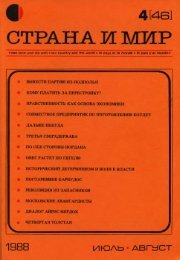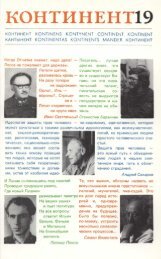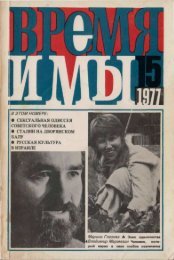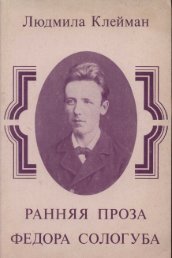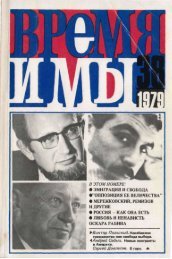Умывшись и свернув на полинялом теменинаследие былой златой своей красы,служительница муз, без мужа и без племени,уселась за свои дисканты и басы.Her piano is described as follows: "Na trech nogach—kormilec lakirovannyj—/zaplakal cernokrylyj krokodil." ("Zizn' Frederiki Forst", 25)In Ten' i telo shadow is opposed to reality. A central place is occupiedby the poet struggling with reality, the broad daylight, the bright coloursand the din, all of which obtrude on him and make it impossible for theinner music to be evoked, for the authentic images to be called forthfrom out of the shade. Fettered to that world—'oppressive, dazzling,deceptive' (26)—there is on the one hand the dream which brings diversionfrom the day-to-day world. On the other hand, we see that theburden of days is hung on 'three nails, three miracles, the three sisters,Faith, Hope and Charity.' (22) The theme of Ten' i telo is concisely andclearly formulated in the last stanza of "Potonuvsij Kolokol" (32):О, взгляните в глубь покоя,в дом, упавший в водоем —в отраженье, в жизнь, из коеймы живыми — не уйдем!The poet is advised to stand as close to the light as possible for the contoursof his shadow to be as sharp as can be: "poblize k svetu stan',poet/ostanes'sja chot' siluetom." (46)A figure Prismanova frequently employs is the replacement of oneimage in an antithetical pair with another image derived from theoriginal one. In the poem "Ten' i telo" for instance we see how the oppositions"noc'-den'" and "snovidenie-jav'" remain nicely in step witheach other until the expected "dusa" (as the counterpart of "telo") failsto appear. Instead "ten"' is introduced to counterbalance "dusa",which not only has an alienating effect, but also gives greater depth tothe image. This is the sort of figure which Prismanova uses on a largescale. Throughout her work words seem to lead lives of their own,developing new symbolic meanings. The opposing worlds of the poetare reflected in "roza" (day)—"roz"' (night). The poet herself is representedas a drudge (sluzanka)—gypsy woman (cyganka), Cinderella(Zoluska)—fortune-teller (gadalka). The autumn leaf (osennij list)stands for dying off, a loathing for life, death. "Pero-krylo-ptica"represents the poetical instrument and inspiration.
This principle seems to underlie the whole of Prismanova's work:time and again we see a shift in imagery when a thematical change occurs,while the basic oppositions remain intact. The pair of images"sluzanka" (telo)—"cyganka" (ten') of Ten* i telo transforms into"cinovnik" (kosf)—"kusnec" (krov') in Bliznecy.In this collection Prismanova develops into an 'imaginary' poetess.Original, funny and fairy-like is the dancing soul walking the tightropein undersized boots (10), the soul that has outgrown her dress (14) andthe dream walking about in seven-league boots (13). The image of thegypsy-woman is surely one of the finest in the collection: "Pjata ее vzole i zolotye/pustye busy v zolobe kljucic" ("Cyganka", 23).A highlight is also the poem "Razve pomnit sadovnik, otkinuvsijstekla к vesne", dedicated to Vladislav Chodasevic (27). Exceptionalthrough its anapestic foot, its closing stanza captures the essence ofPrismanova's outlook on life in this terse image: "Ved' i chram ne uslysit,как padaet telo sveci,/otdavavsej po kaple sebja na s"eden'emolitve."The structure of this collection is not yet as well thought-out as is thecase with her later volumes. Some poems have no title and the collectionis not subdivided into cycles, nor does it have an opening or concludingpoem. Most poems in this collection are dated and have been written inthe period between 1931 and 1936. (With the exception of the 1924"Zelenyj dvorik" (8) and "Napugany voron'im graem" (36), written in1929.) They have not been arranged in chronological order but accordingto content. For instance, the three poems containing references tothe poet Lermontov ("Nedolgovecna polnaja luna" (28), "Doroga"(29), "Najdja mesok nezdesnego dobra" (30)) have been groupedtogether although they were written in different periods. The openinglines of "Gobelen", written in 1936, seem to react directly to the openingof the preceding poem: "Ne oscuscaja sobstvennogo gruza", apoem composed in 1932.Bliznecy, Prismanova's longest collection, has a more rigid structure:an opening and closing poem embrace six cycles of equal length.In Bliznecy Prismanova employs the antithetical pair of images"krov'"—"kosf ", or, as she states in the opening poem of this collection:"kost' trezvosti i krov' ognja."There are frequent references to biblical imagery and parables, suchas the miraculous draught of fishes and the seed on the rock. The themeof the original sin is dealt with in "Zmej" (70) and "Jad" (71). Thesymbol 'blood' is replaced with snake poison (venom), which Prisma—
- Page 3 and 4: Russian Emigre Literaturein the Twe
- Page 5 and 6: © Copyright 1990 Leuxenhoff Publis
- Page 8 and 9: PREFACEDuring the academic year 198
- Page 10: When Prismanova died in 1960 litera
- Page 15 and 16: y M. Slonim. Volja Rossii paid much
- Page 17 and 18: V. Chodasevic was the driving force
- Page 19 and 20: not been able to win over to his po
- Page 21: permanent world. There is always a
- Page 25 and 26: the tone she has adopted is very hu
- Page 27 and 28: The younger poets preferred the iam
- Page 29 and 30: point the author intervenes: "vmest
- Page 31 and 32: NOTES1 There is a recollection of P
- Page 34 and 35: ТЕНЬ ИТЕЛО1. Памяти
- Page 36 and 37: И озирая бедный сво
- Page 38 and 39: 6. КЛЕВЕРПоутру и зд
- Page 40 and 41: Молочных чувств да
- Page 42 and 43: Томительно, как вдо
- Page 44 and 45: 15. КАРАНДАШМарине Ц
- Page 46 and 47: Селеньям в осень вп
- Page 48 and 49: Голодает населенье
- Page 50 and 51: Ее встречает с радо
- Page 52 and 53: 25. ЖИЗНЬ ФРИДЕРИКИ
- Page 54 and 55: О, в жаровне над жар
- Page 56 and 57: 29. ДОРОГАСпи, топол
- Page 58 and 59: С одышкой мы в этаж
- Page 60 and 61: К полудню посетит е
- Page 62 and 63: Но кратче день. Тум
- Page 64 and 65: Две ветки выстроил
- Page 66 and 67: АлександруГингеру
- Page 68 and 69: Напрасно ветер вес
- Page 70 and 71: Он тих снаружи. Бар
- Page 72 and 73:
ПРЕЕМСТВЕННОСТЬ49.
- Page 74 and 75:
Родители забыли по
- Page 76 and 77:
53. ЗЕМЛЯНевольно ос
- Page 78 and 79:
56. БАБУШКАИзъяны пр
- Page 80 and 81:
Бывает жизнь и жити
- Page 82 and 83:
Земля от солнца и д
- Page 84 and 85:
Противницей со мно
- Page 86 and 87:
Замерзло наше ябло
- Page 88 and 89:
Как жар пустыни, жа
- Page 90 and 91:
К потере сердца — п
- Page 92 and 93:
А. Г.Есть пустота —
- Page 94 and 95:
В молчании, конечно
- Page 96 and 97:
Жестокий час! Опасн
- Page 98 and 99:
82. ГРАНИТВо мне одн
- Page 100 and 101:
85. ТРЕУГОЛЬНИКОбыч
- Page 102 and 103:
их не пугает гибель
- Page 104 and 105:
Все было просто, бу
- Page 106 and 107:
В прах, где родител
- Page 108 and 109:
Бьет к берегу солен
- Page 110 and 111:
О, гордая вершина Э
- Page 112 and 113:
Снег мостом спуска
- Page 114 and 115:
Душа не с ним, она н
- Page 116 and 117:
Натертые ночным мо
- Page 118 and 119:
Ночь. Кошка гуляет
- Page 120 and 121:
Начало дня душа про
- Page 122 and 123:
Вадиму АндреевуЗа
- Page 124 and 125:
Даны ему земное ухо
- Page 126 and 127:
Лилит не любит прах
- Page 128 and 129:
Фургон подобно кор
- Page 130 and 131:
соль118.Когда-б ко мн
- Page 132 and 133:
Пусть нет для жажды
- Page 134 and 135:
Грохочет гром... Но
- Page 136 and 137:
Тот знает, кто во ть
- Page 138 and 139:
Послушна голове мо
- Page 140 and 141:
IБольная женщина в
- Page 142 and 143:
— Определенно осуж
- Page 144 and 145:
Влачится он на скол
- Page 146 and 147:
Но как мне быть с мо
- Page 148 and 149:
Углы летящих лебед
- Page 150 and 151:
От этой части днем
- Page 152 and 153:
Неосторожно назван
- Page 154 and 155:
ВступлениеОпять, в
- Page 156 and 157:
Я строю дом... не из
- Page 158 and 159:
Наступает лето баб
- Page 160 and 161:
В русалочьей ночно
- Page 162 and 163:
Сроднятся-ль с ваши
- Page 164 and 165:
О том что знаю и чег
- Page 166 and 167:
Дитя стояло у больш
- Page 168 and 169:
как друг, она труди
- Page 170 and 171:
Днем спит она, сжим
- Page 172 and 173:
И все-ж китайский м
- Page 174 and 175:
Молчит китаец: стар
- Page 176 and 177:
ВЕРА Лирическая по
- Page 178 and 179:
Что ты делаешь, нев
- Page 180 and 181:
Гулко ходят часовы
- Page 182 and 183:
В тот год когда (в м
- Page 184 and 185:
И только широкий и
- Page 186 and 187:
170. топни-ножкойНе б
- Page 188 and 189:
Они тащились на воз
- Page 190 and 191:
Стараясь до высоко
- Page 192 and 193:
Нет здесь синих нез
- Page 194 and 195:
Как рыба что уткнул
- Page 196 and 197:
Над царством тучи н
- Page 198 and 199:
Зиму в ссылке, в неу
- Page 200 and 201:
От героизма тянет х
- Page 202 and 203:
UNCOLLECTED POEMS194.Нет вес
- Page 204 and 205:
Где-же тот Наполеон
- Page 206 and 207:
бьет рубанком — ин
- Page 208 and 209:
Мы заламываем руки:
- Page 210 and 211:
Отец был в то утро з
- Page 212 and 213:
Шли хмельные (конеч
- Page 214 and 215:
Внимательно меж пн
- Page 216 and 217:
По пескам и по щебн
- Page 218 and 219:
Юродивый над нивой
- Page 220 and 221:
Ты узнала с давних
- Page 222:
Бывает пясть из мра
- Page 225 and 226:
звук музыкальной ш
- Page 227 and 228:
свою музыкальную н
- Page 229 and 230:
nait maintenant tout horizontal, li
- Page 231 and 232:
Le clocher du presbytère fit enten
- Page 233 and 234:
aux volets percés de cœurs. C'ét
- Page 235 and 236:
mes dents jaunes. De son sabot inca
- Page 237 and 238:
à recouvrir deux autres bras, eux
- Page 240 and 241:
NOTESPoemsThese notes contain all s
- Page 242 and 243:
Невзрачен дом ее, н
- Page 244 and 245:
1 3 О времени не спра
- Page 246 and 247:
О кривизна забытог
- Page 248 and 249:
Published earlier in Новосел
- Page 250 and 251:
160. „Общение". — Вер
- Page 252:
203. „Пастухи". — Нов
- Page 255 and 256:
Закат (Не помню —* в
- Page 257 and 258:
Сад (Под осень сад,



